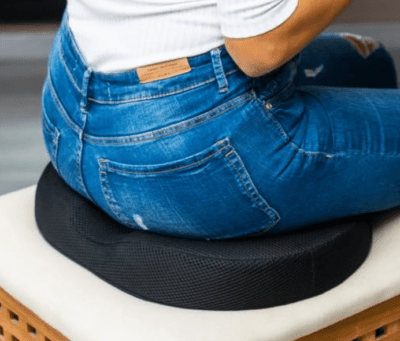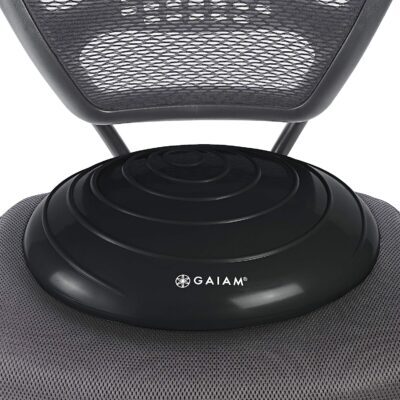If you are one of the millions of people suffering from lower back pain from sitting at a desk, or craving for well-deserved comfort while you work – you don’t have a buy a new and expensive ergonomic office chair.
With just a few simple and ingenious office chair DIY modifications (some are completely cost-free) – you can transform your chair to support your back and prevent back pain and discomfort.

No fancy tools or rocket science here – just straightforward solutions to upgrade your seating experience.
(You can use some of these DIY ideas for your living room recliners as well!)
Ergonomic office chairs, often designed with advanced features and brand recognition, can come with a significant price tag ranging from hundreds to thousands of dollars.
On the other hand, DIY modifications can fix many of the problems with standard chairs, for a fraction of the cost (or at no cost at all).
Overview
The Problems with Your Basic Office Chair
Based on surveys, studies, expert opinions, and personal experience, here are the common problems that can cause or promote further back and neck pain when you sit:
1. Lack of Lumbar Support
Many standard chairs lack proper lumbar support, leading to lower back discomfort and poor posture.
2. Limited Adjustability
Limited adjustable features (such as reclining, armrest height, etc.) make it challenging for people to customize the chair to their unique body shapes and sizes.
For example, a lack of armrest adjustability can cause strain on the shoulders and arms.
3. Poor Seat Cushioning
Inadequate seat cushioning in standard chairs can result in discomfort, especially during extended periods of sitting, and even aggravate issues like numbness and pressure points.
4. Unsupportive Backrests
Backrests in standard chairs may lack the necessary contouring and support, leading to slouching and potential back pain.
5. Wrong Height
Chairs with fixed heights can be problematic, causing discomfort for people whose feet don’t reach the floor or, conversely, those whose knees are higher than their hips.
6. Hard or Uncomfortable Materials
The use of hard or uncomfortable materials in standard chairs can lead to fatigue and discomfort, especially when used for long periods.
For example, plastic chairs are often inexpensive and easy to clean, but they can be uncomfortable for long periods of sitting
and tend to trap heat and moisture.
7. Limited Mobility
Chairs with no swivel or mobility features can prevent natural movements, which may lead to stiffness and discomfort.
8. Insufficient Breathability
Lack of breathable materials in standard chairs can lead to discomfort and sweating, especially in warmer climates, impacting overall well-being.
Here are all the ways you can easily fix these problems, for a low cost:
DIY Ergonomic Chair: 10 Add-Ons to Make It Back-Friendly
DIY desk chair solutions might include items you can find at home, like lumbar support pillows, foam cushions, or even repurposed materials like towels or blankets.
These materials are often affordable and easily accessible. Here’s how to use them:
1. Lumbar Support Pillow
Attach a small pillow or cushion to the lower back area of the chair to provide lumbar support.
You can secure it with straps or fabric loops.
The exact placement for a lumbar pillow is behind the lumbar spine, above the pelvis, where the lower back curve is.
According to Dr. Alan Mandell, many people make the mistake of placing the lumbar pillow too low, which fails to provide proper support.
Here’s exactly where to place it:

Alternatively, you can get an ergonomic lumbar pillow for a relatively low price on Amazon.
2. Towel Roll Lumbar Support
You don’t necessarily need a specialized lumbar pillow; a rolled-up towel can be used effectively to support the lower back and promote proper posture:
Roll up a towel and place it horizontally at the lower back curve. This towel can be adjusted for firmness and height.
3. Seat Cushion Upgrade
Enhance the seat comfort by adding a memory foam or gel cushion (choose a medical coccyx pillow if you suffer from tailbone pain!)
Memory foam and gel cushions are designed to distribute weight evenly and reduce pressure on the spine, hips, and tailbone.
They can also improve your posture, and how they conform to your body’s shape makes your chair seat customized for you, while being much more comfortable.
Secure the cushion with fabric or Velcro straps for stability. If it is wide enough, you won’t need to do that.
4. Adjustable Armrests
If your chair lacks adjustable armrests, attach padded blocks or cushions to the existing armrests for customizable support.
You can make your own armrests by cutting firm foam blocks into the height and width you need and covering them with fabric.
An easier way is to get Armrest Extenders – attachments that extend the length and width of your existing armrests, or memory foam armrest pads.

5. Footrest Addition
For chairs that don’t support sitting at a 90-degree angle between your knees and the floor, add a small footrest, or make one using a sturdy box covered with a soft material, or even just an old suitcase.
To keep the best sitting posture, your feet need to make steady and comfortable contact with the floor.
A footrest can also prevent the legs from hanging uncomfortably and developing varicose veins and blood clots.
You can find a tutorial for a DIY footrest here.
6. Swivel Base Addition
Convert a stationary chair into a swivel chair by attaching a swivel base. You can salvage one from an old office chair or purchase one separately.
A swivel base can help you be more mobile when you sit and use your legs to move around and get your blood moving.
It also solves a height problem if your chair is too low.
7. Tennis Ball Massage
Tape two tennis balls together and attach them to the backrest at the height of your lower back.
Make sure they do not touch your spine, but the muscles surrounding it instead.
This provides a simple massage effect while you sit.
You just lean back and move your lower back against them for quick pressure point relief.
Alternatively, you can get a massage pillow to massage and soothe your lower back while you work.
It comes with straps to keep it from moving and shuts off automatically after 15 minutes.
8. Wooden Bead Seat Cover
Attach a wooden bead seat cover to improve air circulation and reduce heat buildup during long periods of sitting. Plus, you can lean against the beads and get a good pressure point massage whenever you feel you need it.
9. DIY Ergonomic Seat Wedge
Craft a seat wedge from foam or folded towels to promote a slight forward tilt of the pelvis, encouraging a more natural spinal curve.
10. Inflatable Stability Disc
Here’s one of the best ways to engage your core muscles, improve your posture, and prevent slouching – an inflatable stability disc.
Sitting on a balance disc cushion encourages active and dynamic sitting: to keep the balance, you’ll need to constantly make small adjustments in the way you sit.
The unstable surface of the disc requires you to engage the core muscles to maintain balance, which can help strengthen the abdominal and back muscles.
We love this clever idea.
Always ensure that your DIY modifications are secure, stable, and comfortable.
Experiment with these ideas to find a combination that works best for your specific chair and personal preferences.
The Importance of Ergonomics in Your Desk Chair
Think of ergonomic design in chairs like a custom-tailored suit for your body.
It’s not just about looking good; it’s about feeling good too.
Imagine sitting in a chair that understands your body’s curves and supports them.
Ergonomic chairs are designed to keep your spine in a happy, natural position.
This isn’t just about avoiding a sore back; it’s about preventing the aches and pains that can sneak up on you after long hours at your desk.
So, in a nutshell, ergonomic chairs are your body’s best ally, ensuring you feel comfy and well-supported throughout your day.
To your health and happiness,
The Back Pain Relief Team




